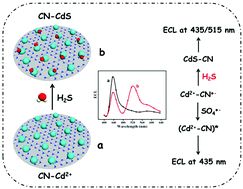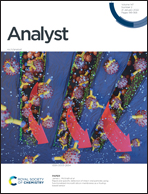Dual-wavelength electrochemiluminescence ratiometry for hydrogen sulfide detection based on Cd2+-doped g-C3N4 nanosheets†
Abstract
Herein, a novel and facile dual-wavelength ratiometric electrochemiluminescence-resonance energy transfer (ECL-RET) sensor for hydrogen sulfide (H2S) detection was constructed based on the interaction between S2− and Cd2+-doped g-C3N4 nanosheets (NSs). Cd2+-doped g-C3N4 NSs exhibited a strong ECL emission at 435 nm. In the presence of H2S, CdS was formed in situ on g-C3N4 NSs by the adsorption of S2− and Cd2+, generating another ECL emission at 515 nm. Furthermore, the overlapping of the absorption spectrum of the formed CdS and the ECL emission spectrum of g-C3N4 NSs led to a feasible RET, thus quenching the ECL intensity from g-C3N4 at 435 nm. Through an ECL decrease at 435 nm and an increase at 515 nm, a dual-wavelength ratiometric ECL-RET system for H2S was designed. The sensor exhibited a lower detection limit of 0.02 μM with a wide linear range of 0.05–100.0 μM. In addition, the applicability of the method was validated by plasma sample analysis with a linear range of 80.0–106.0%. We believe that such a proposal would provide new insight into advanced dual-wavelength ECL ratiometric assays.

- This article is part of the themed collection: Analyst HOT Articles 2021


 Please wait while we load your content...
Please wait while we load your content...